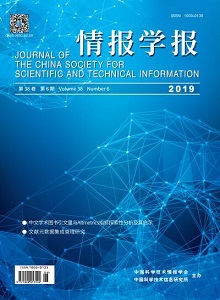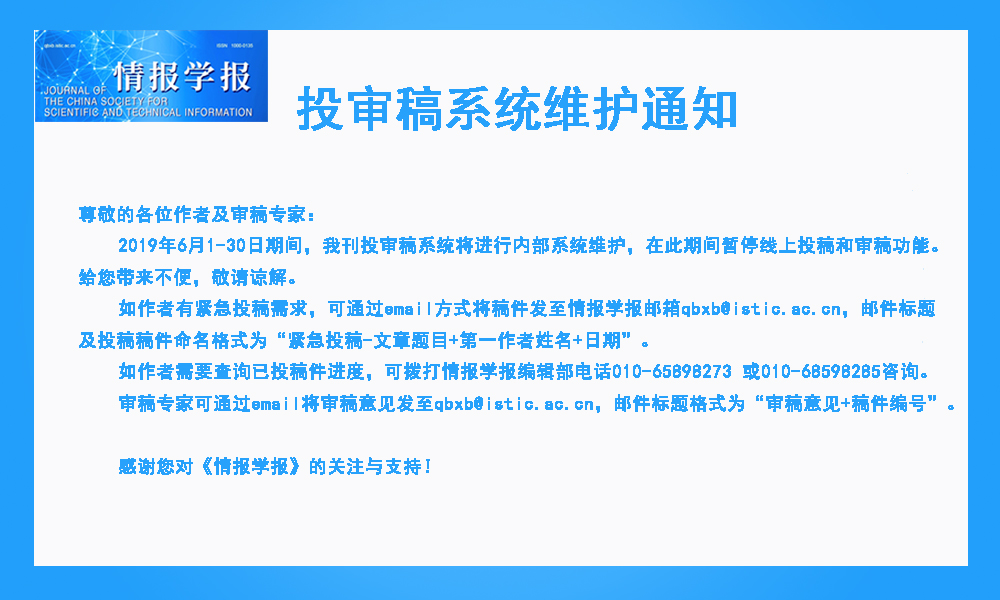 |
|
2019 Vol. 38, No. 6
Published: 2019-06-28 |
|
|
| |
|
|
|
|
|
578 |
Research on Hotspots and Trends of Domestic Text Mining Based on Cluster Analysis Hot! |
|
 |
Tan Zhanglu, Peng Shengnan, Wang Zhaogang |
|
|
DOI: 10.3772/j.issn.1000-0135.2019.06.003 |
|
|
Understanding research hotspots and trends in the field of domestic text mining has immense significance in mastering the development and changes in domain content and promoting further development of the related research. First, this study uses the research literature of 1155 text mining related topics in CNKI database from 1998 to 2017 as the sample and the word frequency matrix of the article keywords as the data. It employs the SPSS software for cluster analysis. Further, the chi-square statistics are used to extract high-degree keywords to interpret the clustering results. According to the clustering results, the literature in the text mining field is divided into 13 categories from the macroscopic level to grasp the research hotspots and trends of domestic text mining. The results show the following: (i) The research on basic research of text mining, text big data preprocessing, and text mining application field are hot topics, (ii) the amount of applied research literature related to association rules, text clustering, and text classification is small, and (iii) text topic analysis, text big data preprocessing, and web text mining research are likely to become new research trends in the future. |
|
|
2019 Vol. 38 (6): 578-585
[Abstract]
(
714
)
HTML
(109 KB)
PDF
(946 KB)
(
2114
) |
|
|
|
622 |
An Ontology Fusion Method Based on Binary Similarity Calculation Hot! |
|
 |
Lou Wen, Wang Hui, Ju Yuan |
|
|
DOI: 10.3772/j.issn.1000-0135.2019.06.007 |
|
|
Heterogeneous ontology causes redundancy in knowledge retrieval. Therefore, knowledge fusion based on heterogeneous ontology is necessary. However, because of the massive capacity and complicated processes required for semantic similarity computing, knowledge fusion has become less simple. In this paper, we propose an ontology fusion method based on binary metrics of semantic similarity calculation. In the fusion process, there will be only binary matching, thus aiming to further simplify the calculation of fusion from semantic similarity. Thus, the present research represents a shift from methods locating computing progress at the beginning of original ontology construction. We adopted three experiments to test the usability of our approach, from the perspectives of (1) actual library resources, (2) a small dataset, and (3) a large dataset. In experiment one, bibliographic data from Wuhan University Library were used to test our proposal s feasibility and capabilities. Results showed that our approach can completely merge two ontologies into a single theme. The second and third experiments both verified that our approach has the ability to accurately detect merging couples and decrease time cost. The tests demonstrated a good overall fusion result; nevertheless, recall requires future improvement. This method is expected to extend the implementation of expert ontology and aid in cost reduction of ontology construction. |
|
|
2019 Vol. 38 (6): 622-631
[Abstract]
(
249
)
HTML
(122 KB)
PDF
(1205 KB)
(
733
) |
|
|
|
632 |
A Novel Recommendation Approach of Electronic Literature Resources Combining Semantic and Social Features Hot! |
|
 |
Yang Chen, Liu Tingting, Liu Lei, Niu Ben, Sun Jianshan |
|
|
DOI: 10.3772/j.issn.1000-0135.2019.06.008 |
|
|
With the arrival of the era of information expansion, the load on electronic literature databases will dramatically increase, and it will become increasingly difficult for users to search for their required pieces of literature. In response to this issue, the development of recommendation systems to assist the management of electronic literature databases has received extensive attention from researchers. Currently, one commonly used recommendation technique for literature databases is collaborative filtering. However, the traditional collaborative filtering algorithms, which only consider the similarity of users’ search-history, ignore several important factors, such as the users’ semantic similarity and social relationships. In this paper, we integrated a text content similarity based on topic model as well as two kinds of user similarities based on social relationships (user tag similarity and personal group similarity) into the user collaborative filtering recommender system by utilizing an unsupervised integration strategy. The experiment on the real data set shows that by adding the multiple source features, there is an enhancement and promotion effect on the recommendation accuracy, which provides strong implications for related electronic literature resource recommendation research in the future. |
|
|
2019 Vol. 38 (6): 632-640
[Abstract]
(
284
)
HTML
(109 KB)
PDF
(1020 KB)
(
926
) |
|
|
|
655 |
Exploring UsersInformation Source Selection and Use Strategies in Learning Related Search Hot! |
|
 |
Song Xiaoxuan, Liu Chang |
|
|
DOI: 10.3772/j.issn.1000-0135.2019.06.010 |
|
|
With the volume of information increasing and online quality in question, it becomes more difficult for users to acquire appropriate information that satisfies their needs and enriches their knowledge by using search engines. When searching, usersinformation selection and subsequent use depend largely on information sources. A user experiment was conducted in order to design two kinds of tasks, one related to receptive learning and the other to critical learning. This study focused on the differences in the distribution of information source types during the usersprocess of source selection and use. It also explored the relationship between usersinformation source strategies and their learning outcomes. The results showed that users were more dependent on the information sources they ultimately selected rather than those recommended by search engines. According to the degree of dependence, four types of information source strategies were identified: total dependence, non-dependence, selective dependence, and use-dependence. We also found that usersinformation source strategies had significant impact on learning outcomes. Users adopting non-dependent strategies for receptive learning-related tasks, as well as those adopting total dependence strategies for critical learning-related tasks, could achieve better learning outcomes. This study contributes by clarifying the characteristics of usersinformation sources during selection and subsequent use in order to optimize search engine systems to improve userslearning outcomes by providing accurate and efficient guidance. |
|
|
2019 Vol. 38 (6): 655-666
[Abstract]
(
239
)
HTML
(118 KB)
PDF
(1276 KB)
(
1208
) |
|
|
|


